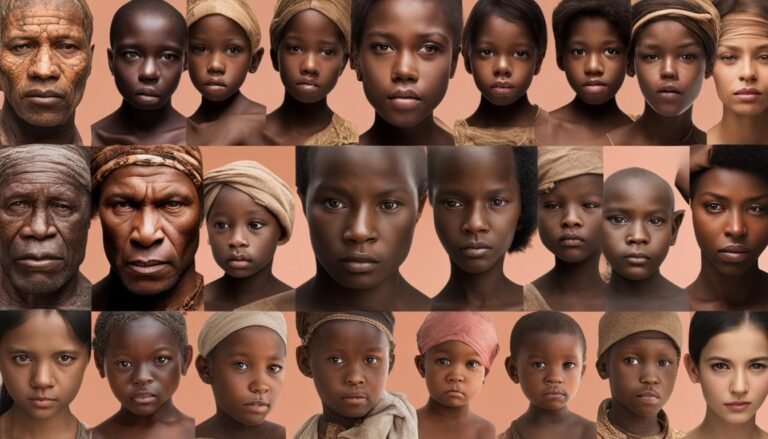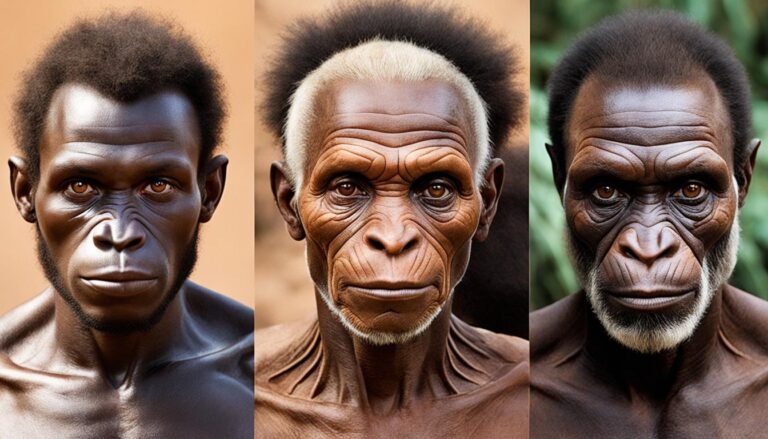What color were Adam and Eve?
Have you ever wondered about the skin color of Adam and Eve, our common ancestors according to the Bible? Despite their central role in the creation narrative, the Scriptures do not explicitly mention their pigmentation. This has left room for cultural interpretations and curious minds to delve into the unique factors that determine human skin and hair color.
Scientific research sheds light on the primary determinants of skin pigmentation: the two pigments – eumelanin and pheomelanin. Eumelanin, a dark brown color, and pheomelanin, a reddish brown hue, are responsible for the range of skin tones among humans. The production of these pigments is influenced by genetic and biochemical factors, shaping the diversity we observe in human appearances.
Key Takeaways:
- The Bible does not explicitly mention the skin or hair color of Adam and Eve, leaving it open to interpretation.
- Scientific research reveals that skin pigmentation is primarily determined by the presence of eumelanin and pheomelanin.
- Genetic and biochemical factors play a significant role in the production and balance of these pigments, resulting in the wide range of skin tones among humans.
- Adam and Eve’s pigmentation likely allowed for the diversity of skin and hair colors among their descendants.
- The Scriptures emphasize the unity of all humans as descendants of Adam and Eve, regardless of their external appearances.
The Biblical Perspective on Human Diversity
In the Bible, it is stated that all humans are descendants of Adam and Eve. This means that despite our diverse physical traits, we are fundamentally connected as one race. The story of Noah’s Ark provides further insight into the origin of human diversity. After the flood, Noah and his family repopulated the Earth, giving rise to different people groups with distinct characteristics.
One of the most visible aspects of human diversity is skin pigmentation. It is likely that the combination of genes inherited from Adam and Eve, along with subsequent genetic variations and mutations, contributed to the wide range of skin colors we see today. The genetic variations that determine skin pigmentation have allowed for the development of different melanin levels in various populations, resulting in unique skin tones.
The Science Behind Skin Pigmentation
Human skin pigmentation is primarily determined by the presence and distribution of melanin, a pigment produced by specialized cells called melanocytes. There are two main types of melanin: eumelanin, which is responsible for darker skin colors, and pheomelanin, which imparts a reddish or yellowish hue to the skin. The production of these pigments is influenced by a complex interplay of genes and environmental factors.
The specific genetic variations that control melanin production and distribution can vary among different populations. These variations have developed over time through natural selection and adaptation to different environments. In regions with higher exposure to ultraviolet (UV) radiation, such as near the equator, a higher concentration of melanin is advantageous in protecting the skin from the harmful effects of the sun. In areas with lower UV radiation, lighter skin tones allow for better absorption of vitamin D, essential for bone health.
Furthermore, the migration of populations across different geographic regions and the mixing of genetic material through interbreeding have also contributed to the diverse range of skin colors we observe today.
“The Bible teaches us that we are all descendants of Adam and Eve, and this shared ancestry highlights our fundamental unity as human beings, regardless of our external appearances.”
This biblical perspective on human diversity offers a powerful message of inclusion and equality. Regardless of our skin color or physical differences, we are all part of the same human family. Acknowledging and celebrating our shared ancestry can help foster understanding, respect, and appreciation for the diversity of humanity.
| Population | Percentage of Dark Skin | Percentage of Light Skin |
|---|---|---|
| African | 90% | 10% |
| Asian | 50% | 50% |
| European | 10% | 90% |
| Native American | 40% | 60% |
This table illustrates the approximate distribution of dark and light skin percentages in different populations. It highlights the diversity of skin pigmentation across various ethnic groups.
The Image of God and Human Equality
In the book of Genesis, the concept of the “image of God” teaches us that every human being, regardless of their race or ethnicity, carries a unique dignity and worth. This shared image of God is what makes all people equal and deserving of respect.
The Bible strongly condemns prejudice and mistreatment based on race or ethnicity. Insulting or oppressing others because of their socio-economic status or ethnic background is considered an affront to God’s design for humanity.
It is important to note that the curse of Ham, often misunderstood to support racial discrimination, is actually referring to the Canaanites rather than people of African descent. Throughout biblical Israel, we see a diverse mix of peoples, demonstrating the inclusivity of God’s plan for humanity.
The Bible calls us to recognize the intrinsic equality of all human beings and to reject racial prejudice. Regardless of our differences, we are all created in the image of God, and that should be the foundation for treating one another with respect and dignity.






